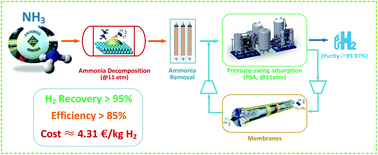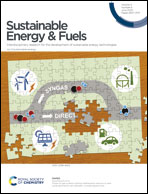Techno-economic analysis and comprehensive optimization of an on-site hydrogen refuelling station system using ammonia: hybrid hydrogen purification with both high H2 purity and high recovery†
Abstract
Ammonia (NH3) has been considered to be a promising hydrogen storage medium owing to the carbon-free features, easy liquefaction storage, low transportation costs, and potential ammonia production from renewable energy sources. On-site hydrogen production using ammonia decomposition offers a sustainable and cost-efficient solution for hydrogen refuelling stations, and separating H2 from a H2–N2 mixture is a necessary step to obtain high-purity H2 (>99.97%). In the scale of a hydrogen refuelling station (∼300 Nm3 h−1), using pressure-swing adsorption (PSA) is not feasible owing to its low recovery, while using polymeric membranes cannot meet the H2 purity demand. To achieve both a high H2 purity and high H2 recovery, we developed a physical-chemical system model of a 300 Nm3 h−1on-site NH3-fed hydrogen refuelling station to optimize a H2 purification subsystem, and furthermore predicted the system efficiency and economic feasibility. We validated our system model using experimental data, and compared eight different scenarios of H2 purification subsystems. The results reveal that a NH3-fed on-site hydrogen refuelling station using a “PSA-to-membrane” subsystem is a feasible method of producing high-purity H2 with a H2 recovery greater than 95%, which is 29% higher than a system only using PSA. Correspondingly, the system efficiency increased from 59.1% to 85.37%, and the total specific cost was reduced by 22% to 4.31 € per kg. The feedstock cost accounts for 74% of the total specific cost. Using our optimized hybrid H2 purification subsystem, the H2 production cost of the NH3-fed on-site hydrogen refuelling station was at least 15% lower than other carbon-free routes (such as electrolysis, solar thermolysis, photo-electrolysis, etc.), and comparable to that of a methane steam reforming system with carbon capture and storage.



 Please wait while we load your content...
Please wait while we load your content...